Chasing butterflies with a net and collecting was a popular pursuit for several hundred years. Nowadays catching and killing these glorious creatures is frowned upon by ecologists and nature-lovers everywhere. An exciting and absorbing way of butterfly hunting today, however, could take the form of a collection of beautiful butterfly books.
Butterflies are the most easily recognisable and attractive of insects, with their intricately-patterned and brilliantly coloured wings and graceful flight in the sun. They cannot bite, sting, nor carry disease, and rarely damage crops; and the mysteries of their life-cycle have long evoked man's admiration and affection.
The evolution of butterflies as we know them probably started at least 200 million years ago. They are first depicted in Chinese and Egyptian paintings dating back some 3,500 years, and in mediaeval times butterflies formed part of the decorative borders of old manuscripts. The European Renaissance saw the development of a new curiosity about natural history, but it was not until the 17th century that there was any serious study of butterflies recorded in Britain.
In 1634, Thomas Moffett's Insectorum Theatrum became the first printed account of some 17 butterflies native to Britain. These insects were not given names, and, but for the primitive woodcut illustrations, they would have been difficult to identify from Moffett's fanciful but obscure Latin descriptions. Moffett, incidentally, is reputed to have been the father of Miss Muffett, famous for her frightening encounter with the nursery-rhyme spider!
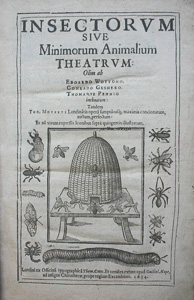 | 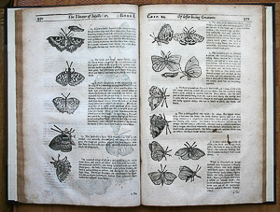 |
| Title Page of Moffett's Insectorum Theatrum, first published in Latin Image © David Dunbar | Example Page from Moffett's Insectorum Theatrum, English version of 1658 Image © David Dunbar |
The acquisition of A.A. Lisney's Bibliography of British Lepidoptera, 1608-1799 (1960), provides the interested collector with a useful short cut to the study of 17th and 18th century butterfly books. This meticulous and scholarly reference work details all the known books and other literature of the period. Sadly, most collectors will probably find the cost of these early books beyond their means, even if they are lucky enough to find copies for sale. This article, therefore, has been restricted to highlighting a few of the more significant authors and their works.
In 1666, Christopher Merrett describes 21 species in the Pirax Rerum Naturalium Brittanicarium. Just over 60 are to be regularly found in Britain, so it is a curious selection, especially as some common butterflies have been omitted in preference to rarer ones. Intriguingly, he includes the Purple-edged Copper butterfly which, although still found in Europe, has never been seen in Britain. It is interesting to speculate whether this butterfly once flew here, only to become extinct before reliable records were available.
By the end of the 17th century collectors had undoubtedly discovered most of the British species. 48 feature in John Ray's Historia Insectorum (1710). Following 7 years later came the first book devoted wholly to British butterflies, Papilionium Britanniae, by James Petiver who identified and engraved images of some 48 species.
One of the most artistic, as well as one of the most precious, books on British lepidoptera must be The Aurelian (1766), by Moses Harris. Exquisite copperplate engravings, hand coloured, depict 33 butterflies together with many moths. The frontispiece of the book is of particular interest as it shows two fashionably dressed 18th century gentlemen collecting insects along a woodland ride. The book ran to several editions, the last of which appeared in 1840. The word "Aurelian" derives from the name taken by early butterfly collectors, and originated from the gold (aureolus) colour found on the chrysalis of butterflies such as the Small Tortoiseshell or Peacock.
 |
| A plate from Moses Harris' Aurelian, first published in 1766 Image © David Dunbar |
Another superb book, illustrated with 46 engravings of a quality comparable to modern works, is The Insects of Great Britain (1795), by William Lewin. Only the book about butterflies was published before his death.
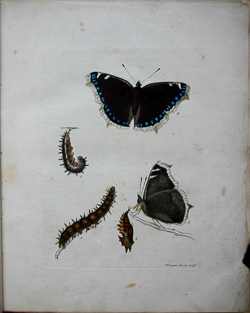 |
| Camberwell Beauty plate from Lewin's The Insects of Great Britain of 1795 Image © David Dunbar |
English names now had wide usage, although at first there was a lack of consistency which led to many butterflies having several different names. These often reflected a particular characteristic (the Swallowtail); the colour or locality in which it was found (Meadow Brown); or even a connection with a celebrity of the time (Duke of Burgundy). The scientific naming and classification system, devised and first published in 1735 by the Swedish naturalist Carl Linne (Carolus Linnaeus), was gradually adopted and developed. Short, simple names based on ancient Greek or Latin words became universally accepted. R.D. Macleod's Key to the Names of British Butterflies and Moths is a useful "dictionary" which translates the original names into English.
The word "butterfly" itself is thought possibly to originate from the bright "butter" yellow Brimstone which is often the first of its kind to be seen on the wing in springtime. The word "lepidoptera", the generic term for butterflies and moths, derives from the Greek "lepis" (scale) and "ptera" (wings).
The 19th century saw a proliferation of both learned and modest books. All but a few of the British butterflies had been discovered, so writers concentrated on the classification of these insects, along with biological study, field observations and their geographical distribution. Cheap editions of the grander works, simple guides, and books for children gave a new stimulus for the ordinary person to indulge in a pleasurable hobby. The huge collections of butterfly in many of our museums were assembled by the Victorian gentlemen with their butterfly nets.
This period also challenges the ingenuity and perseverance of today's collector of books. Whilst many deal solely with butterflies, others on natural history or more general works invariably contain interesting sections on Lepidoptera. were frequently studied in parallel, and this is reflected by numerous books covering both the day and night flying insects. Few collectors will resist the temptation to move into this field as well.
In 1869, Edward Newman published a History of British Butterflies. The black-and-white woodcut engravings enhance this classic reference work, which can still be bought relatively cheaply in reasonable condition.
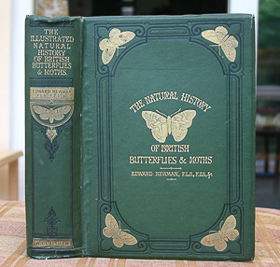 |
| Edward Newman's Lepidopteral work in typical Victorian binding Image © David Dunbar |
The lepidopterist's appetite for knowledge was well served by the publications of numerous handbooks, guides and manuals. Their profusion is matched only by the variety of their accuracy and quality. Some worthy of mention are H.T Stainton's A Manual of British Butterflies and Moths (1857) in 2 volumes; E. Merrick's A Handbook of British Lepidoptera (1895) - best edition 1927; W. Kirby and W. Spence's Entomology (1815 - 1826), 4 volumes (later popular editions can still be found); W.S. Coleman's British Butterflies, with numerous additions (1860 - 1903); and J.O. Westwood's Classification of Insects (1840).
 |
| Several editions of Coleman's popular British Butterflies Image © David Dunbar |
From the rectory in his Yorkshire country parish, the Reverend F.O. Morris busied himself compiling lengthy natural history works. Among these were a History of British Butterflies (1853), with 70 hand-coloured plates and 4 volumes of a History of British Moths (1872). The drawings are lifelike but the colouring can sometimes be poor. Both were extensively revised in later editions, but one does wonder whether his parishioners' spiritual welfare received equally-conscientious attention! Browsers are also likely to come across the Reverend W.E. Kirby's European Butterflies and Moths (1882), a coffee table book which has exceptionally fine colour plates and is possibly underrated by collectors.
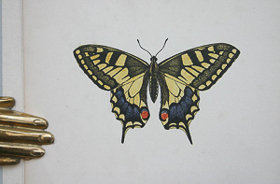 | 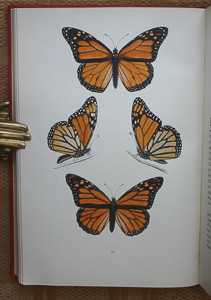 |
| The Swallow Tail from Rev F O Morris' Natural History of British Butterflies Image © David Dunbar | The recently discovered Monarch from a later edition of Morris' Butterflies Image © David Dunbar |
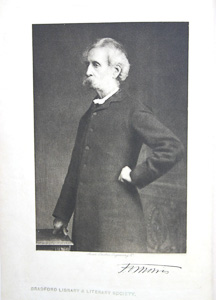 |
| A rare portrait of Morris Image © David Dunbar |
Typical of the success of Victorian publishers was British Butterflies and their Transformations (1841), by H.N. Humphreys and J.O Westwood. A description of every known species was accompanied by 42 delightfully hand-coloured engraved plates. Each butterfly with its caterpillar and chrysalis is shown against an artistic background of flowers and the caterpillar food plant. Cheaper versions of the same book appeared later in the titles of The Butterflies of Great Britain (1855 - 1887) and The Genera and Species of British Butterflies (1860).
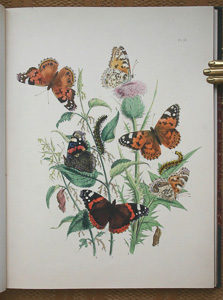 |
| Superb hand-coloured painting from The Transformations of British Butterflies by H N Humphreys and J O Westwood Image © David Dunbar |
The enthusiasm of the 19th century collector resulted in the formation of numerous national and local societies. Many fell by the wayside but others have survived. The Royal Entomological Society founded in 1833 flourishes today and is the leading learned society in the country. Countless journals and publications emanated from those organisations and offer the collector great scope in finding rarer and original scientific material.
In 1906, Richard South's Butterflies of the British Isles was published by Frederick Warne and Company in the Wayside and Woodland series. In print for the best part of 70 years, this book's success was due to the easily readable text, convenience of size for the pocket, and the clear illustrations of male, female and wing undersides of all the British butterflies. A companion volume on the caterpillars of butterflies appeared in 1944.
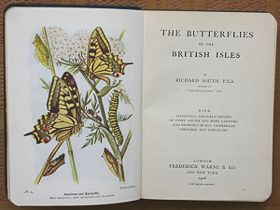 |
| First edition of Richard South's Butterflies of the British Isles Image © David Dunbar |
Undoubtedly, F.W. Frohawk's Natural History of British Butterflies, 1924, must form the cornerstone of any modern collection of butterfly books. A lifetime of work was devoted to studying, recording and painting the life cycles of all the British butterflies. For the first time the egg, caterpillar, chrysalis and adult insect of every butterfly was depicted in remarkably accurate and minute detail, many of the figures being made from the microscope. Even today the 60 colour plates are the best reference for identifying the early growth stages. The book, in 2 folio volumes, contains the first account of the extraordinary life cycle of the Large Blue butterfly, which unhappily became extinct in Britain but is now the subject of a successful reintroduction. With a colleague, Frohawk found that for much of its life the caterpillar of this butterfly lived underground in an ants' nest, feeding on a sticky secretion produced by the ant grubs. After a winter's hibernation it changes into a chrysalis, and the butterfly emerges in the following summer. A condensed version of this book was published in 1934 under the title The Complete Book of Butterflies, and is worthy of attention because of the new material and attractive lifelike drawings in the text.
 |  |
| Detail from F W Frohawk's Natural History of British Butterflies Image © David Dunbar | Detail from F W Frohawk's Natural History of British Butterflies Image © David Dunbar |
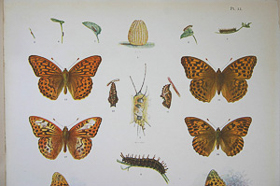 |
| Frohawk's meticulous detail Image © David Dunbar |
Another book worthy of mention is the first work to use distribution maps for each species. Butterfly Book for the Pocket by Edmund Sandars was published in 1939; the first edition is worth finding as it has unusual silver metallic printing for the appropriate markings of the fritillary butterfly wings.
In 1946, Collins embarked on their New Naturalists series by publishing Butterflies by E.B. Ford. This book and subsequent titles in the series heralded a new high standard of reading for the amateur naturalist. Moths, dragonflies, spiders, bumblebees and other insect groups were among those covered by leading writers and the series has recently published the one hundredth title.
L. Hugh Newman, the well known children's broadcaster, writer and butterfly farmer, popularised the collection and breeding of butterflies and moths with more that a dozen books written during the 1950s and 1960s. Founded by his father, Newman's butterfly farm in Kent supplied livestock to amateur and professional entomologists all over the world. Sir Winston Churchill, a butterfly enthusiast, ordered large quantities of butterfly livestock for the grounds of Chartwell. Butterfly Haunts (1946), Butterfly Farmer (1954), Create a Butterfly Garden (1967), Living with Butterflies (1967) and other titles regularly turn up in second-hand bookshops.
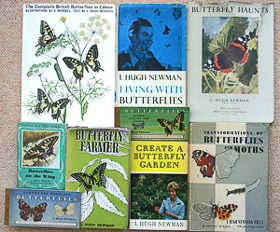 |
| Some of the titles by L Hugh Newman, the popular writer and broadcaster Image © David Dunbar |
Many butterfly collectors have specialised in catching specimens with rare or unusual wing patterns or colouration. This is a complex branch of lepidoptera, reflected by the scarcity of books on the subject. One of the most sought after is Frohawk's final work, The Varieties of British Butterflies, published in 1938. Superseding this book, but largely based on it, is A.D.A. Russwurm's Aberrations of British Butterflies, which is still in print. Probably the best study and classification of varieties found in an individual species is the Monograph of the British Chalk-Hill Blue (1938), by Bright and Leeds. Similar genetic researches into butterflies have led to major scientific discoveries, such as advances into combating rhesus disease in babies.
Countless interesting books about butterflies have been produced in recent years and a knowledge of the subject will enable the collector to decide those meriting a place in their library. The camera has now replaced the butterfly net as the means of assembling a visual collection. With the serious decline in butterfly numbers throughout the country, the days of collecting are over, but a close-up shot of a brilliantly-coloured butterfly like the Red Admiral or Small Tortoiseshell is no less satisfying. The first book to contain coloured photographs of every British butterfly is Robert Goodden's British Butterflies - A Field Guide (1978). 15 years of photography by Margaret Brooks resulted in the Complete Guide to British Butterflies (1982), which has photographs of the life stages of every butterfly - a remarkable achievement. Gardening to encourage and breed butterflies is the theme of Clive Farrell and Miriam Rothschild in their book Butterfly Gardener. They also tell how to keep exotic tropical species in your greenhouse!
In the last twenty years an astonishing number of books have appeared. Amateur and professional lepidopterists have assembled a vast new array of information and knowledge. The near universal use of computers for writing and processing data has lead to sophisticated presentation and easy colour printing. The studies and advances are available to a much wider audience in relative cheap and attractive books which are a joy to own and read.
Early writers seemed little troubled by the killing of butterflies to form a collection. In 1860, W.S. Coleman wrote: "few will deny that man enjoys a vested right to make use of any of the inferior animals, even to the taking of their life, if the doing so ministers to his own well-being or pleasure". Today the need for conserving our wildlife is widely recognised. The emphasis in today's books is increasingly on butterfly ecology, habitat management and the protection of our flora and fauna. Undoubtedly, these are the future themes for the collector, and books already touching on conservation are likely to receive special acclaim and the attention of collectors in years to come.
David is a main council member of Butterfly Conservation, and the proprietor of Aurelian Books.